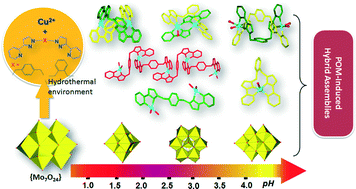Isopolymolybdate-induced organic–inorganic hybrid assemblies with copper ions and bichelate-bridging ligands†
Abstract
The heptamolybdate [NH4]6[Mo7O24], as a common polyoxometalate (POM) precursor with dynamic configuration transformation in aqueous solution by changing the pH, has been introduced into the hydrothermal reaction system containing copper ions and bichelate-bridging ligands, leading to the isolation of seven new organic–inorganic hybrid compounds [CuI2Lo2][Mo6O19] (1), [CuII2Lo2][β-Mo8O26]·2H2O (2), [CuII4Lo2(pypz)4][α-Mo8O26]·3H2O (3), [CuII4Lp4(H2O)4][α-Mo8O26][β-Mo8O26]·4H2O (4), [CuI4Lp3][β-Mo8O26]·H2O (5), [CuI4Lp4][α-Mo8O26] (6), and [CuI2Lp2(Emim)2][β-Mo8O26] (7) (bis(3-(2-pyridyl)pyrazole-1-ylmethyl)benzene = bppmb, Lo = 1,2-bppmb, Lp = 1,4-bppmb, pypz = 3-(2-pyridyl)pyrazole, Emim = 1-ethyl-3-methylimidazolium). All compounds were characterized by elemental analysis, IR spectroscopy, TG analysis, powder X-ray diffraction and single-crystal X-ray diffraction analysis. The structural analyses show that the isopolymolybdate clusters act as a type of “molecular adaptor”, which modulate the coordination mode of metal–organic subunits, leading to a series of new metal–organic secondary building units, such as the “Möbius-Ring”-type binuclear unit, “S”-type binuclear unit, butterfly-type unit, helical chain and mesomeric helical chain. As a result, the POM anions and the metal–organic subunits have suitable matching modes to form new hybrid self-assemblies. The photocatalytic properties of compounds 1–7 for the degradation of Rhodamine-B (RhB) under UV irradiation were investigated. All compounds showed good catalytic activity. Furthermore, the luminescent properties of compounds 1–7 have also been explored, indicating an organic ligand-based emission mode for all compounds.


 Please wait while we load your content...
Please wait while we load your content...